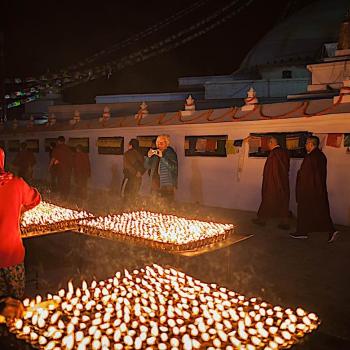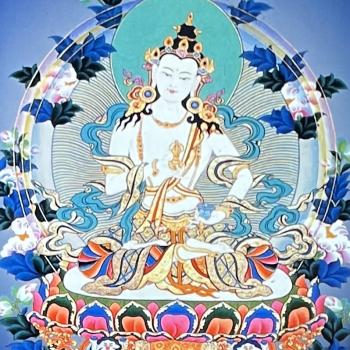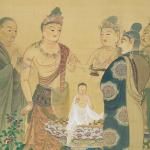This text “the 37 practices of a Bodhisattva” is a concise text written by a Tibetan teacher in the 14th century named Togme Zangpo who was a member of the Sakya lineage. It’s a summary of how we should behave as we are on the path to awakening. It’s a Tibetan Mahayana teaching.
18
When you are down and out, held in contempt,
Desperately ill, and emotionally crazed,
Don’t lose heart. Take into you
The suffering and negativity of all beings — this is the practice of a bodhisattva.
I think of the blues song “Nobody Knows You When You’re Down and Out.” It was written by Jimmy Cox in the 1920s, but covered by Eric Clapton and made famous in 1970. It’s about fair-weather friends, people who are around all the time when you’re successful but seem to be gone as soon as things get hard, when you’re desparately ill or emotionally crazed. I think about what they call hitting ‘rock bottom’.
This is a reference to a practice called tonglen. This is a practice where we visualize ourselves taking on the suffering of others and returning happiness to them. That’s what taking in the suffering and negativity of all beings is about.
When things are going bad, when we are poor and struggling, it can be easy to develop an “oh poor me” attitude. It can be easy to get overwhelmed and give up. In this way we tend to make bad situations become worse.
If we can extend our scope of attention beyond our limited selves, then our way of experiencing these kinds of difficulties can be different. We can expand our scope by thinking in terms of exchanging ourselves for others. My happiness is your happiness.
Because we are one. If we can expand our awareness beyond just this one individual person that we call, “I” then we won’t be so discouraged.
Here are tonglen meditation instructions. By the way: I didn’t write these, Pema Chodron wrote them:
“On the in-breath, you breathe in whatever particular area, group of people, country, or even one particular person… maybe it’s not this more global situation, maybe it’s breathing in the physical discomfort and mental anguish of chemotherapy; of all the people who are undergoing chemotherapy. And if you’ve undergone chemotherapy and come out the other side, it’s very real to you. Or maybe it’s the pain of those who have lost loved ones; suddenly, or recently, unexpectedly or over a long period of time, some dying. But the in-breath is… you find some place on the planet in your personal life or something you know about, and you breathe in with the wish that those human beings or those mistreated animals or whoever it is, that they could be free of that suffering, and you breathe in with the longing to remove their suffering.
And then you send out – just relax out… send enough space so that peoples’ hearts and minds feel big enough to live with their discomfort, their fear, their anger or their despair, or their physical or mental anguish. But you can also breathe out for those who have no food and drink, you can breathe out food and drink. For those who are homeless, you can breathe out/send them shelter. For those who are suffering in any way, you can send out safety, comfort.
So in the in-breath you breathe in with the wish to take away the suffering, and breathe out with the wish to send comfort and happiness to the same people, animals, nations, or whatever it is you decide.
Do this for an individual, or do this for large areas, and if you do this with more than one subject in mind, that’s fine… breathing in as fully as you can, radiating out as widely as you can.”
19
Even when you are famous, honored by all,
And as rich as the god of wealth himself,
Don’t be pompous. Know that the magnificence of existence
Has no substance — this is the practice of a bodhisattva.
People are proud of a lot of things, a lot of times people are proud of things they have no control over, like heritage or nationality.
This makes me think of the film Pulp Fiction. In it the mob boss played by Ving Rhames says to the boxer played by Bruce Willis: “Pride only hurts. It never helps.”
I think he’s right. Pride is a way of separating ourselves from others, of putting ourselves on a pedestal above other people. And all the things we are proud of are fundamentally impermanent, just like everything else. I can be proud of something I’ve done, like getting a promotion at work, but in the end the results of that aren’t going to last. And it can be easy to look down on others that didn’t get the promotion I’m proud of. And at the other end of the spectrum is pride for things I have no control over. I can be proud of my nationality but…I didn’t choose that. It just happened to me.
20
If you don’t subdue the opponent inside, your own anger,
Although you subdue opponents outside, they just keep coming.
Muster the forces of loving kindness and compassion
And subdue your own mind — this is the practice of a bodhisattva
About responding with anger, Buddhaghosa said: “By doing this you are like a man who wants to hit another and picks up a burning ember and so first burns himself.”
Like pride, anger is something that brings us a lot more harm than help.
Anger happens to all of us. Even the greatest among experience anger sometimes; regardless of how much we have cultivated love and compassion, we are still human.
In Buddhism, anger is one of the three poisons, along with greed and ignorance. The three poisons are the primary cause of our suffering. Striving to overcome our anger is essential to Buddhist practice. In Buddhism, we don’t really think of anger as ‘righteous’ or ‘justifiable’. It’s important to remember that our anger hurts us as much as it hurts whoever the target of our anger is, if not more. Anger is nothing more than an impediment to our inner peace. We might think, “this person deserves to be faced with my anger.”
But that shouldn’t be our line of thinking—instead, we should be thinking, “Is our anger helpful?”
So, we can strive to overcome our anger, but of course we will get angry sometimes, everyone does and we shouldn’t feel bad for it.
First, admit you’re angry. Admit that your anger is clouding your judgment and impacting your ability to deal with whatever situation is occurring. Anger can only get in the way and escalate situations. It never helps. Thinking anger is sometimes helpful is dangerous. Buddhism teaches mindfulness. Being mindful of our own emotions is part of mindfulness. We don’t suppress a negative emotion or deny it; instead we acknowledge it and try to recognize that it isn’t helpful and let it go.
It’s also important to understand that our anger is created by ourselves.
Anger doesn’t happen to us, our minds create it. We tend to think that someone else causes us to get angry, but it’s our own mind that makes us angry. We do have some control over how we respond to situations.
As Buddhists, our practice is to cultivate kindness and compassion for all beings that is free from attachment. “All beings” includes individuals who make us angry.
For this reason, when we experience anger, we should take care not to act on it to hurt others and ourselves. We also must take care not to cling to our anger. If we hold onto our anger over time, it is only more damaging to us.
How do we let our anger go?
One thing we can do it cultivate patience. We can sit still with our anger and try to release it. Our meditation practice helps us strengthen our patience for this purpose.
It’s hard not to act on our anger sometimes. It takes strength to acknowledge that anger is not helpful and it takes discipline to let it go.
The Buddha said, “Holding onto anger is like picking up a hot coal to throw at someone.”
Even if we succeed at hurting the other person, we are hurting ourselves as well.
Is it ever really worth it?
—————————————————————————–













